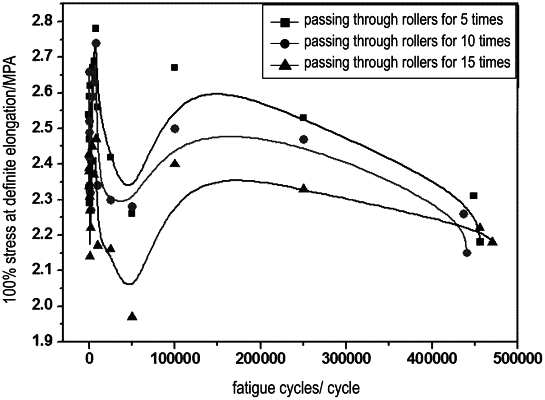| CPC G01N 3/34 (2013.01) [G01N 3/06 (2013.01); G01N 2203/0005 (2013.01); G01N 2203/0017 (2013.01); G01N 2203/0073 (2013.01); G01N 2203/025 (2013.01); G01N 2203/0268 (2013.01); G01N 2203/0298 (2013.01); G01N 2203/0682 (2013.01); G01N 2203/0688 (2013.01); G01N 2203/0694 (2013.01)] | 7 Claims |

|
1. A testing and characterization method for an initial fatigue damage and development process of vulcanized rubber, wherein the method comprises the following steps:
(1) preparing vulcanized rubber:
preparing a rubber compound according to a test formula designed for testing rubber, and vulcanizing the rubber compound to obtain a vulcanized test piece;
(2) preparing test samples:
cutting the vulcanized test piece into type 2 dumbbell-shaped test samples according to the requirements specified in GB/T 528-2009, and recording each 5 of dumbbell-shaped test samples as one group;
(3) preparing fatigue testing specimens:
testing the fatigue life of the test samples by using a fatigue tester, and firstly carrying out a fatigue life test on one set of test samples to obtain the number of fatigue life cycles of the test samples;
setting a pre-set number of fatigue test cycles of the test samples according to the total fatigue life cycles of the test samples;
testing in accordance with GB/T 1688-2008; after the test samples are tested for the pre-set number of fatigue cycles, taking off the test samples from the fatigue tester to obtain fatigue testing specimens;
(4) characterizing the initial fatigue damage and development process:
determining the stress at definite elongation of the fatigue testing specimens of different fatigue cycles by using a tensile machine, and plotting for the fatigue cycles by using the stress at definite elongation to obtain a fatigue life curve,
wherein in the curve results:
from the starting point of the curve, along with the increase of the fatigue cycles, if the stress at definite elongation drops linearly, this section of curve characterizes that the vulnerable structure in the rubber is damaged; if the curve is gentle, the curve represents that the inner structure of the rubber is not damaged;
subsequently, along with the increase of the fatigue cycles, if the stress at definite elongation increases to the first peak, this section of curve characterizes that macromolecular chains in the rubber slip and short chains in a chemical cross-linked structure extend to produce an orientation; a higher peak characterizes a greater produced amplitude of variation;
subsequently, along with the increase of the fatigue cycles, if the stress at definite elongation drops to the trough, this section of curve characterizes that a carbon black aggregate in the rubber is separated from a rubber matrix to produce micro-damages; a higher dropping amplitude of the curve characterizes a higher speed at which the damages occur; a lower trough of the curve characterizes a more severe degree of damages;
subsequently, along with the increase of the fatigue cycles, if the stress at definite elongation increases to the second peak, this section of curve characterizes that initial damages of the rubber appear, micro-damage points in the rubber propagate and the macromolecular chains in the rubber are oriented; a higher height of the second peak in the curve characterizes a greater extent of orientation;
finally, along with the increase of the fatigue cycles, if the stress at definite elongation slowly drops, this section of curve characterizes that micro-cracks in the rubber propagate until the macrostructure is damaged; and a longer dropping duration of the curve characterizes a longer fatigue life of the rubber.
|